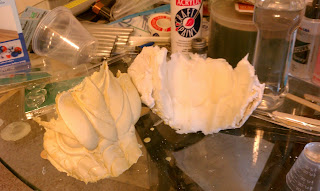 |
| The flesh-tone stuff around the eye is modeling putty. It stays pliable almost forever unless its heated. All it's for here is to prevent the resin from running out. |
To make sure there was no spillage I created a wall around the hole with modeling clay. That would allow me to over-fill the space a little (it's easier to remove excess material than it is to add it). I clamped the mold and face together with spring clamps, and then I clamped the whole assembly to the table to keep it level over-night. I took care to mix the resin without incorporating any bubbles, and when I unmolded the piece the following day (re-unmolded?) the eye was exactly the right shape and securely and neatly bonded to the surrounding face. I repeated the technique I had used previously to polish the cornea (a few drops of resin on the rough surface), and another day later the results were even better than I had hoped!
 |
| Right eye right out of the mold. The black spring clamp in the picture is just there to give some contrast to the eye. |
 |
| This is the right eye polished up. The iris is simply scratched in the back of the cornea with the tip of a screwdriver. I wish I had taken a picture before I'd scratched the iris in. |
I arranged with Dean a time to present my proof-of-concept so I could move on to working on the original sculpture. I suppose it should have been a warning as I was getting ready to take everything out to show him that I had to go to great lengths to pack everything in sealable containers so nothing would get damaged or lost en route. It took a bit of time to re-wire my demonstration electronics and to sort and stack all the parts I'd built. The result was a rickety pile that only displayed the illusion I was hoping for if the observer viewed it from directly above. Dean was non-plussed, and I can't say I disagreed with him. To be frank I had no idea at that point how I was going to get all those parts to remain together, and the stack was taller than half the width of the dragon's head into which I planned to fit two of them (the eyes are on opposite sides of the head).
On the positive side: Dean really liked the look of the clear resin cornea I'd poured in my reproduction of the dragon's face. There were a couple small bubbles in the resin that became more visible when the light was shone through, and the bubbles were causing the light to bounce in an interesting way. Dean actually liked how they looked, and he pointed out that if the resin was full of bubbles the light being refracted from all of them would diffuse the light shining through and make it visible from all directions.
Dean gave me the go-ahead to start cutting on the original to at least get that component started. Not having an iris however would mean the ultraviolet LEDs would have nothing to make them visible (reflect a visible wavelength), so I would have to switch to an LED with a color in the visible spectrum. I hadn't cancelled my order for the ultra-bright purple LEDs from China, so having an iris painted with fluorescent purple pigment won't technically be essential (assuming they ever arrive). I did experiment with etching the back of the resin cornea to make it resemble a slit-pupil iris though, and Dean wasn't entirely opposed to the way it looked.
Back at home I repeated the process I'd used to pour the first eye on the other side, but instead of taking my time to mix the resin gently I beat the hell out of it to incorporate as many bubbles as possible. As I was about to pour the resin I had an idea: rather than etching a slit-pupil I could cast one. The resin I had just mixed had a milky appearance from the quantity of bubbles, and the etching I'd used on the clear cornea wouldn't be visible anyway. I took one of the clear lenses I'd created previously as an experiment and cut it with my band saw into an oblong shape. This I set into the mold before I poured the new resin. Without all the bubbles the clear (old) resin was denser than the new, bubbly resin, so gravity held it in place while the resin cured. After a layer of polish was added the resulting eye actually looked rather nice (if I do say so myself) if a little rough (the mold is starting to show signs of wear).
 |
| The left eye. The mold has been damaged by constantly putting the reproduction in and out of it (my fault). Nonetheless, I like the result. I'll probably make the pupil narrower in the final version. |
I now have the original dragon sculpture in my workshop, so I have work to do. First I have to create a new mold that's easier to work with and in better shape than the one I currently have. Next I have to grind out the existing eyes (this could be difficult: the resin of the original sculpture is much thicker in some places than the reproduction with which I've been working). Then I have to pour new eyes (having a vastly different space in which to work than with my proof-of-concept). Finally I have to wire the electronic components.
Coming soon: Assembly!









